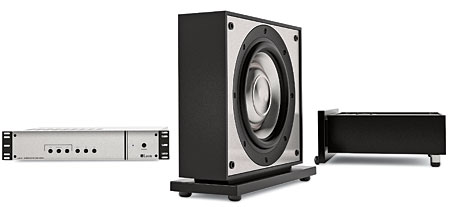Leon Horizon 212 Speaker System Page 2
Leon doesn’t offer a satellite speaker with matching 2-inch woofers. Perhaps that’s not such a bad thing. Instead, this system uses the Detail Series Ds113 in the surround channels, a two-way sat with 3-inch woofers. As with the soundbar, its speaker terminals are plastic-tab spring-loaded wire clips, my least favorite type. Leon is examining the possibility of upgrading to the standard screwdown binding posts that it uses in the rest of its product line.
Unusual Sub
That brings us to the meat of the story: the Aaros A10-UT subwoofer and the L3-1K sub amp that drives it. The sub came in a wooden crate with eight very tenacious crosshead screws. It packs its 10-inch aluminum-coned driver into a shallow cabinet just 4.5 inches deep. This impressively solid sealed enclosure is made partially of aluminum, which makes it both heavy and relatively nonresonant. I’ve never seen anything like this before. Connectivity is via a pair of binding-post speaker inputs that connect to the outboard amp. The passive sub has no amp of its own, but Leon only sells it with the L3-1K amplifier. You can use it freestanding, in-wall, or down-firing (in cabinet, or under tables or seating). Leon supplies the kit for down-firing installation.

The outboard amp has maximum connectivity, with both speaker- and line-level inputs and outputs as well as an LFE-in if you prefer to set the sub crossover in your surround processor. It provides the flexibility of bass equalization, with controls for frequency, bandwidth, and level—so you can notch out any bass hump that your room presents. There are also the usual controls for gain, crossover frequency, and phase (continuously variable from 0 to 180 degrees). Power is rated at 497 watts into 8 ohms, and 950 watts into 4 ohms, RMS.
Of course, to set EQ properly, you’ll need to measure your room’s bass response. Leon doesn’t offer anything for this purpose. I used the Infinity R.A.B.O.S. kit, which sells online for $60. I like the R.A.B.O.S. kit because it includes both a testtone CD and a sound pressure level meter that’s specifically designed for measuring bass. If you already have an SPL meter, Mordaunt-Short also offers a test CD made just for subwoofers. Although I haven’t tried it, there’s another disc from Rives Audio that’s calibrated for use with RadioShack SPL meters.
More setup notes: In designing the soundbar, Leon deliberately concentrated on the frequency range from 210 hertz to 20 kilohertz. The company contends that with corrective EQ, the soundbar can reach down to the THX Ultra2–specified subwoofer crossover of 80 Hz (although none of this system is THX certified). This is an ambitious goal, and it’s not at all likely to produce anywhere near reference levels in real-world rooms. Leon further recommends that you apply corrective EQ from 210 Hz down to 80 Hz with a boost of 9 decibels per octave. For that purpose, the company recommends the Audyssey auto setup and room-correction system licensed for many A/V receivers and surround processors. [See HT Labs Measures. Our experience with compact loudspeakers doesn’t support the contention that using EQ to extend this speaker’s response, even taking into account boundary reinforcement from wall-mounting, will result in enough output capability to make an 80-Hz crossover plausible in most installations.—Ed.]

Since my A/V receiver doesn’t include EQ and I don’t maintain an outboard equalizer in my reference system, I instead set a sub crossover of 120 Hz and settled for less than optimum performance from 120 Hz to 210 Hz. Any higher, and the sub would call undo attention to itself. If you’d like to avoid this problem without jumping through hoops, you can always buy one of Leon’s larger soundbars, which use larger woofers and are claimed to offer more bass response.
As I was setting up the system with test tones and an SPL meter, I uncovered a couple of irregularities. The soundbar’s center channel was far louder than the left and right. According to Leon, the speaker was designed to be 4 to 6 dB hot. According to my SPL meter, it was more like 8 dB. This is an unusually high variation. Most speaker systems I review have channel-level variations of no more than 3 dB. Since this was a design decision, not a manufacturing defect, I knocked down the center level in the surround processor and proceeded. Once the channels were balanced, I noticed a major tonal shift among the three front channels, with the left and right noticeably brighter than the center.
- Log in or register to post comments




































































